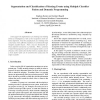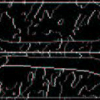ICPR
2004
IEEE
16 years 2 months ago
2004
IEEE
In this paper the segmentation of a meeting into meeting events is investigated as well as the recognition of the detected segments. First the classification of a meeting event is...
ICPR
2004
IEEE
16 years 2 months ago
2004
IEEE
Detection of objects is in general a computationally demanding task. To simplify the problem it is of interest to utilize contextual information and perform a staggered recognitio...
ICPR
2004
IEEE
16 years 2 months ago
2004
IEEE
By treating projectors as pin-hole cameras, we show it is possible to calibrate the projectors of a casually-aligned, multi-projector display wall using the principles of planar a...
ICPR
2004
IEEE
16 years 2 months ago
2004
IEEE
This paper introduces a novel measure for object convexity using the recently introduced Multi-Scale Autoconvolution transform. The proposed measure is computationally efficient a...
ICPR
2004
IEEE
16 years 2 months ago
2004
IEEE
This paper assesses the recently proposed affine invariant image transform called Multi-Scale Autoconvolution (MSA) in some practical object classification problems. A classificat...
ICPR
2004
IEEE
16 years 2 months ago
2004
IEEE
This paper describes a method for curvature dependant Skeletonisation in grey-scale images. We commence from a magnetostatic analogy, where the tangential edge flow (the cross pro...
ICPR
2004
IEEE
16 years 2 months ago
2004
IEEE
102
click to vote
ICPR
2004
IEEE
16 years 2 months ago
2004
IEEE
Feature subset selection, applied as a pre-processing step to machine learning, is valuable in dimensionality reduction, eliminating irrelevant data and improving classifier perfo...
ICPR
2004
IEEE
16 years 2 months ago
2004
IEEE
This paper presents an application of the general sample-to-object approach to the problem of invariant image classification. The approach results in defining new SVM kernels base...
101
click to vote
ICPR
2004
IEEE
16 years 2 months ago
2004
IEEE
When comparing different methods for face detection or localization, one realizes that just simply comparing the reported results is misleading as, even if the results are reporte...


